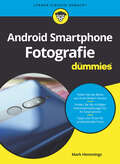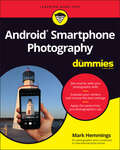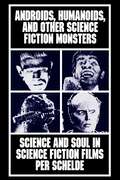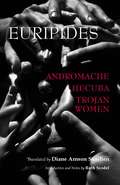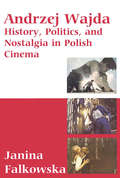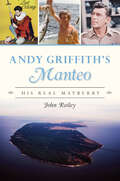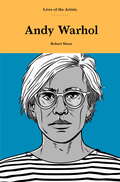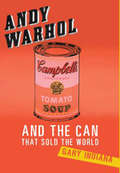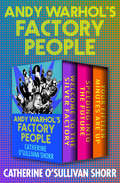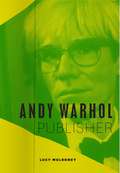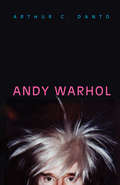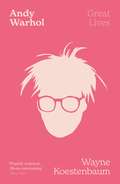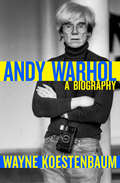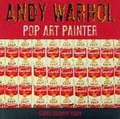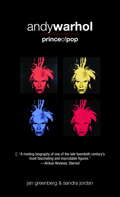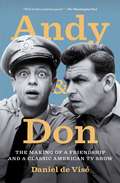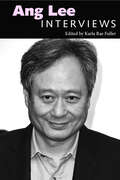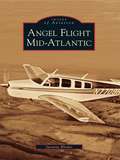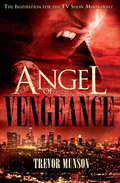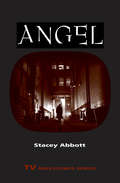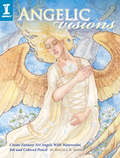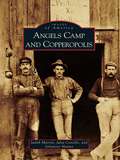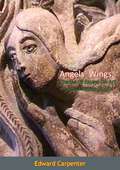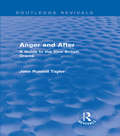- Table View
- List View
Android Smartphone Fotografie für Dummies (Für Dummies)
by Mark HemmingsSie möchten hochwertige Bilder mit Ihrem Android-Smartphone aufnehmen? In diesem Buch erfahren Sie, wie Sie mit der Kamera, die Sie jeden Tag dabei haben, beeindruckende Fotos schießen. Mark Hemmings bringt Ihnen die Grundprinzipien der Fotografie bei und zeigt Ihnen, wie Sie dieses Wissen auf Außenaufnahmen, Actionfotos, Portraits und in Videos anwenden. Außerdem erfahren Sie alles über die Möglichkeiten der Bildbearbeitung und bekommen praktische Tipps, wie Sie Ihre Aufnahmen organisieren und Fotos online teilen.
Android Smartphone Photography For Dummies
by Mark HemmingsWait—you took that amazing picture? Taking a photo is as simple as point and click. Taking a good photo takes a bit more know-how, and Android Smartphone Photography For Dummies is your quick-and-easy guide. No matter what model of Android phone you have, this book teaches you to produce high-quality images using the powerhouse camera you carry in your pocket every day. You’ll learn the photography techniques pros use, like how to recognize beautiful outdoor lightning, how to capture moving subjects, and how to make stuff look good. Whatever kind of photos you want to take, this book will help you identify the gear and the apps you need for stunning results. With Dummies as your friendly instructor, you’ll be wowing your friends and family before you know it. Explore your phone’s camera, including little-known advanced features that will make a big difference in your images Figure out how to edit your pictures, correct lighting imbalances, apply neat filters, remove blemishes, and more Learn the basic principles of photography and apply your knowledge to outdoor photography, action shots, and still life Plus: capture video, organize your images, share photos online, choose a phone tripod, and protect your camera from the elements Dummies makes it easy for Android users of all skill levels to morph into masterful image-makers.
Androids, Humanoids, and Other Folklore Monsters: Science and Soul in Science Fiction Films
by Per ScheldeScience fiction films, from the original Frankenstein and The Fly to Blade Runner and The Terminator, traditionally have been filled with aliens, spaceships, androids, cyborgs, and all sorts of robotic creatures along with their various creators. The popular appeal of these characters is undeniable, but what is the meaning of this generation of creatures? What is the relationship of mad scientist to subject, of human to android, of creature to creator? Androids, Humanoids, and Other Folklore Monsters is a profound investigation of this popular cultural form. Starting his discussion with the possible source of these creatures, anthropologist and writer Per Schelde identifies the origin of these critters in the folklore of past generations. Continuing in the tradition of ancient folklore, contends Schelde, science fiction film is a fictional account of the ongoing battle between nature and culture. With the advance of science, the trolls, dwarves, pixies, nixies, and huldres that represented the unknown natural forces of the world were virtually killed off by ever-increasing knowledge and technology. The natural forces of the past that provided a threat to humans were replaced by the danger of unknown scientific experiments and disasters, as represented by their offspring: science fiction monsters. As the development of genetics, biomedical engineering, and artificial intelligence blur the lines between human and machine in the real world, thus invading the natural landscape with the products of man's techno-culture, the representation of this development poses interesting questions. As Per Schelde shows, it becomes increasingly difficult in science fiction film to define the humans from their creations, and thus increasingly difficult to identify the monster. Unlike science fiction literature, science fiction film has until now been largely neglected as a genre worthy of study and scholarship. Androids, Humanoids, and Other Folklore Monsters explores science fiction (sf) film as the modern incarnation of folklore, emblematic of the struggle between nature and culture—but with a new twist. Schelde explains how, as science conquered the forests and mountains of the wild, the mythic creatures of these realms—trolls, elves, and ogres—were relegated to cartoons and children's stories. Technology and outer space came to represent the modern wild, and this new unknown came alive in the popular imagination with the embodiments of our fears of that unknown: androids, cyborgs, genetics, and artificial intelligence gone awry. Implicit in all of these is a fear, and an indictment, of the power of science to invade our minds and bodies, replacing the individual soul with a mechanical, machine-made one. Focusing his analysis on sixty-five popular films, from Frankenstein and Metropolis to Invasion of the Body Snatchers, The Terminator, and Blade Runner, Per Schelde brings his command of traditional folklore to this serious but eminently readable look at SF movies, decoding their curious and often terrifying images as expressions of modern man's angst in the face of a rapidly advancing culture he cannot control. Anyone with an interest in popular culture, folklore, film studies, or science fiction will enjoy this original and comprehensive study.
Andromache, Hecuba, Trojan Women
by Euripides Ruth Scodel Diane Arnson SvarlienDiane Arnson Svarlien's translation of Euripides' Andromache, Hecuba, and Trojan Women exhibits the same scholarly and poetic standards that have won praise for her Alcestis, Medea, Hippolytus. Ruth Scodel's Introduction examines the cultural and political context in which Euripides wrote, and provides analysis of the themes, structure, and characters of the plays included. Her notes offer expert guidance to readers encountering these works for the first time.
Andrzej Wajda
by Janina FalkowskaThe work of Andrzej Wajda, one of the world's most important filmmakers, shows remarkable cohesion in spite of the wide ranging scope of his films, as this study of his complete output of feature films shows. Not only do his films address crucial historical, social and political issues; the complexity of his work is reinforced by the incorporation of the elements of major film and art movements. It is the reworking of these different elements by Wajda, as the author shows, which give his films their unique visual and aural qualities.
Andy Griffith's Manteo: His Real Mayberry
by John RaileyLearn about the real life of beloved actor Andy Griffith.The world loves Sheriff Andy Taylor. Yet the actor who played him was intensely private. Here, for the first time, is the real Andy Griffith, his career and life defined by the island that made him in the years soon after World War II. He achieved his artistic breakthrough while acting in The Lost Colony drama on Roanoke Island, then spent the rest of his life repaying the island for giving him that start. Here, in unique closeup, is Andy of Manteo, reveling in wild, watery and loving ways with his fellow islanders. Author and journalist John Railey paints an intimate portrait of Andy, based on interviews with many of those who knew him best on the sand where he lived and died.
Andy Warhol (Lives Of The Artists Ser.)
by Robert ShoreKing of Pop Art Andy Warhol is one of the greatest artists of all time. Rarely venturing into public without his camera and tape recorder, Warhol was a great observer and documentarist of the American social scene.Somewhere within the iconic images, carefully-made personae, star-studded milieu, million-dollar price tags and famous quotes lies the real Andy Warhol. But who was he? Andy Warhol,Robert Shore unfolds the multi-dimensional Warhol, dissecting his existence as undisputed art-world hotshot, recreating the amazing circle that surrounded him, and tracing his path to stardom back through his early career and his awkward and unusual youth. After Warhol, nothing would be the same – he changed art forever. Find out how with his remarkable story.‘Lives of the Artists’ is a new series of brief artists biographies from Laurence King Publishing. The series takes as its inspiration Giorgio Vasari's five-hundred-year-old masterwork, updating it with modern takes on the lives of key artists past and present. Focusing on the life of the artist rather than examining their work, each book also includes key images illustrating the artist’s life.
Andy Warhol (Lives of the Artists)
by Robert ShoreKing of Pop Art Andy Warhol is one of the greatest artists of all time. Rarely venturing into public without his camera and tape recorder, Warhol was a great observer and documentarist of the American social scene. Somewhere within the iconic images, carefully-made personae, star-studded milieu, million-dollar price tags and famous quotes lies the real Andy Warhol. But who was he? Andy Warhol,Robert Shore unfolds the multi-dimensional Warhol, dissecting his existence as undisputed art-world hotshot, recreating the amazing circle that surrounded him, and tracing his path to stardom back through his early career and his awkward and unusual youth. After Warhol, nothing would be the same – he changed art forever. Find out how with his remarkable story.‘Lives of the Artists’ is a new series of brief artists biographies from Laurence King Publishing. The series takes as its inspiration Giorgio Vasari's five-hundred-year-old masterwork, updating it with modern takes on the lives of key artists past and present. Focusing on the life of the artist rather than examining their work, each book also includes key images illustrating the artist’s life.
Andy Warhol and the Can That Sold the World
by Gary IndianaIn the summer of 1962, Andy Warhol unveiled 32 Soup Cans in his first solo exhibition at the Ferus Gallery in Los Angeles-and sent the art world reeling. The responses ran from incredulity to outrage; the poet Taylor Mead described the exhibition as "a brilliant slap in the face to America. ” The exhibition put Warhol on the map-and transformed American culture forever. Almost single-handedly, Warhol collapsed the centuries-old distinction between "high” and "low” culture, and created a new and radically modern aesthetic. InAndy Warhol and the Can that Sold the World, the dazzlingly versatile critic Gary Indiana tells the story of the genesis and impact of this iconic work of art. With energy, wit, and tremendous perspicacity, Indiana recovers the exhilaration and controversy of the Pop Art Revolution and the brilliant, tormented, and profoundly narcissistic figure at its vanguard.
Andy Warhol's Factory People: Welcome to the Silver Factory, Speeding into the Future, and Your Fifteen Minutes Are Up (Andy Warhol's Factory People #2)
by Catherine O'Sullivan ShorrBased on the television documentary: A three-part oral history of the Pop Art sensation&’s inner circle and their dazzling world of art, drugs, and drama. Featuring a new introduction by the author, special to this collection, this three-part companion volume to Emmy Award–winning Catherine O&’Sullivan Shorr&’s documentary Andy Warhol&’s Factory People is an unprecedented exposé of an exhilarating and tumultuous time in the 1960s New York City art world—told by the artists, actors, writers, musicians, and hangers-on who populated and defined the Factory. &“Different [in] its avowed bottom-up approach: Warhol as a function of his followers is the idea. This time . . . it&’s the interviews that tell the tale&” (Robert Lloyd, Los Angeles Times). Welcome to the Silver Factory: In 1962, frustrated with advertising work, Warhol sets up his legendary studio in an abandoned hat factory on Manhattan&’s 47th Street. The &“Silver Factory&” quickly becomes the hub of Warhol&’s creative endeavors—the space where he constantly works while an ever-changing cast of characters and muses passes through with their own contributions. Speeding into the Future: In a peak period from 1965 through 1966, Warhol creates the notion of the &“It Girl&” with ingenuous debutante Edie Sedgwick; discovers Lou Reed, the Velvet Underground, and Nico, the gorgeous chanteuse who becomes his next &“It Girl&”; and directs—with Paul Morrissey—his most commercially successful film, the art house classic, Chelsea Girls. Your Fifteen Minutes Are Up: By 1967, it seems that the Factory has outlived its fifteen minutes of fame. Superstars like Edie Sedgwick fall victim to drugs. Factory denizens have falling-outs with Warhol, as do the Velvet Underground, who are also caught up in disputes of their own. Into the chaos comes radical feminist Valerie Solanas, who shoots Warhol and seriously injures him. He survives—barely—but the artist, and his art, are forever changed.
Andy Warhol, Publisher
by Lucy MulroneyAlthough we know him best as a visual artist and filmmaker, Andy Warhol was also a publisher. Distributing his own books and magazines, as well as contributing to those of others, Warhol found publishing to be one of his greatest pleasures, largely because of its cooperative and social nature. Journeying from the 1950s, when Warhol was starting to make his way through the New York advertising world, through the height of his career in the 1960s, to the last years of his life in the 1980s, Andy Warhol, Publisher unearths fresh archival material that reveals Warhol’s publications as complex projects involving a tantalizing cast of collaborators, shifting technologies, and a wide array of fervent readers. Lucy Mulroney shows that whether Warhol was creating children’s books, his infamous “boy book” for gay readers, writing works for established houses like Grove Press and Random House, helping found Interview magazine, or compiling a compendium of photography that he worked on to his death, he readily used the elements of publishing to further and disseminate his art. Warhol not only highlighted the impressive variety in our printed culture but also demonstrated how publishing can cement an artistic legacy.
Andy Warhol: 21 Segi Changjojeok Injaeeui Rolmodel = [andy Warhol] (Icons of America #12)
by Arthur C. Danto&“Astutely traces the ripple effects of Warhol&’s blurring of the lines between commercial and fine art, and art and real life…masterful.&”—Booklist (starred review) Art critic, philosopher, and winner of a National Book Critics Circle Award Arthur Danto delivers a compact, masterful tour of Andy Warhol&’s personal, artistic, and philosophical transformations. Danto traces the evolution of the pop artist, including his early reception, relationships with artists such as Jasper Johns and Robert Rauschenberg, and the Factory phenomenon. He offers close readings of individual Warhol works, including their social context and philosophical dimensions, key differences with predecessors such as Marcel Duchamp, and parallels with successors like Jeff Koons. By drawing on subject matter understandable to the ordinary American, Warhol revolutionized the way we look at art. In this book, Danto brings to bear encyclopedic knowledge of Warhol&’s time and shows us Warhol as an endlessly multidimensional figure—artist, political activist, filmmaker, writer, philosopher—who retains permanent residence in our national imagination.
Andy Warhol: A Biography (LIVES #2)
by Wayne Koestenbaum'Properly analytical ... always entertaining' TIME OUT'Should tempt both those generally familiar with Andy Warhol and, even more, young people who have trouble imagining how popular art can challenge the status quo' L A TIMESPainter, filmmaker, photographer, philosopher, all-round celebrity, Andy Warhol is an outstanding cultural icon. He revolutionised art by bringing to it images from popular culture - such as the Campbell's soup can and Marilyn Monroe's face - while his studio, the Factory, where his free-spirited cast of 'superstars' mingled with the rich and famous, became the place of origin for every groundswell shaping American culture.In many ways he can be seen as the precursor to today's 'celebrity artists' such as Tracey Emin and Damian Hurst. But what of the man behind the white wig and dark glasses? Koestenbaum gives a fascinating, revealing and thought-provoking picture of pop art's greatest icon.
Andy Warhol: A Biography (Lives Ser.)
by Wayne KoestenbaumAn intimate depiction of the visionary who revolutionized the art world A man who created portraits of the rich and powerful, Andy Warhol was one of the most incendiary figures in American culture, a celebrity whose star shone as brightly as those of the Marilyns and Jackies whose likenesses brought him renown. Images of his silvery wig and glasses are as famous as his renderings of soup cans and Brillo boxes—controversial works that elevated commerce to high art. Warhol was an enigma: a partygoer who lived with his mother, an inarticulate man who was a great aphorist, an artist whose body of work sizzles with sexuality but who considered his own body to be a source of shame. In critic and poet Wayne Koestenbaum&’s dazzling look at Warhol&’s life, the author inspects the roots of Warhol&’s aesthetic vision, including the pain that informs his greatness, and reveals the hidden sublimity of Warhol&’s provocative films. By looking at many facets of the artist&’s oeuvre—films, paintings, books, &“Happenings&”—Koestenbaum delivers a thought-provoking picture of pop art&’s greatest icon.
Andy Warhol: Pop Art Painter
by Susan Goldman RubinFollowing award-winning artist biographies "Degas and the Dance," "Toulouse-Lautrec," and "Cezanne," an exciting new book from Abrams Books for Young Readers looks at Andy Warhol. A leader of the American art movement known as Pop, short for "popular culture," Warhol changed the way we think of art. Assisted by photographs taken of Warhol throughout his life, and examples of his early drawings and best-known works, Susan Goldman Rubin traces his rise from poverty to wealth, and from obscurity to fame.
Andy Warhol: Prince of Pop
by Jan Greenberg Sandra JordanThe Campbell’s Soup Cans. The Marilyns. The Electric Chairs. The Flowers. The work created by Andy Warhol elevated everyday images to art, ensuring Warhol a fame that has far outlasted the 15 minutes he predicted for everyone else. His very name is synonymous with the 1960s American art movement known as Pop. But Warhol’s oeuvre was the sum of many parts. He not only produced iconic art that blended high and popular culture; he also made controversial films, starring his entourage of the beautiful and outrageous; he launched Interview, a slick magazine that continues to sell today; and he reveled in leading the vanguard of New York’s hipster lifestyle. The Factory, Warhol’s studio and den of social happenings, was the place to be. Who would have predicted that this eccentric boy, the Pittsburgh-bred son of Eastern European immigrants, would catapult himself into media superstardom? Warhol’s rise, from poverty to wealth, from obscurity to status as a Pop icon, is an absorbing tale—one in which the American dream of fame and fortune is played out in all of its success and its excess. No artist of the late 20th century took the pulse of his time—and ours—better than Andy Warhol.
Andy and Don: The Making of a Friendship and a Classic American
by Daniel De ViséA lively and revealing biography of Andy Griffith and Don Knotts, celebrating the powerful real-life friendship behind one of America's most iconic television programs.Andy Griffith and Don Knotts met on Broadway in the 1950s. When Andy went to Hollywood to film a TV pilot about a small-town sheriff, Don called to ask if the sheriff could use a deputy. The comedic synergy between Sheriff Andy Taylor and Deputy Barney Fife ignited The Andy Griffith Show, elevating a folksy sitcom into a timeless study of human friendship, as potent off the screen as on. Andy and Don--fellow Southerners born into poverty and raised among scofflaws, bullies, and drunks--captured the hearts of Americans across the country as they rocked lazily on the front porch, meditating about the simple pleasure of a bottle of pop. But behind this sleepy, small-town charm, de Visé's exclusive reporting reveals explosions of violent temper, bouts of crippling neurosis, and all-too-human struggles with the temptations of fame. Andy and Don chronicles unspoken rivalries, passionate affairs, unrequited loves, and friendships lost and regained. Although Andy and Don ended their Mayberry partnership in 1965, they remained best friends for the next half-century, with Andy visiting Don at his death bed. Written by Don Knotts's brother-in-law and featuring extensive unpublished interviews with those closest to both men, Andy and Don is the definitive literary work on the legacy of The Andy Griffith Show and a provocative and an entertaining read about two of America's most enduring stars.
Ang Lee: Interviews (Conversations with Filmmakers Series)
by Karla Rae FullerTaiwanese born, Ang Lee (b. 1954) has produced diverse films in his award-winning body of work. Sometimes working in the West, sometimes in the East, he creates films that defy easy categorization and continue to amaze audiences worldwide. Lee has won an Academy Award two times for Best Director--the first Asian to win--for films as different as a small drama about gay cowboys in Brokeback Mountain (2005), and the 3D technical wizardry in Life of Pi (2012). He has garnered numerous accolades and awards worldwide.Lee has made a broad range of movies, including his so-called "Father Knows Best" trilogy made up of his first three films: Pushing Hands (1992), The Wedding Banquet (1993), and Eat Drink Man Woman (1994), as well as 1970s period drama The Ice Storm (1997), martial arts film Crouching Tiger, Hidden Dragon (2000), superhero blockbuster Hulk (2003), and hippie retro trip Taking Woodstock (2009).Thoughtful and passionate, Lee humbly reveals here a personal journey that brought him from Taiwan to his chosen home in the United States as he struggled and ultimately triumphed in his quest to become a superb filmmaker. Ang Lee: Interviews collects the best interviews of this reticent yet bold figure.
Angel Flight Mid-Atlantic (Images of Aviation)
by Suzanne RhodesIn 1972, two pilots--one a federal career engineer, the other the pastor of a prominent church in Washington, D.C.--discovered a common passion for flying airplanes and serving people. One day over lunch, the men conceived a flight plan, one that would undergo many changes before becoming Angel Flight Mid-Atlantic, as it is known today. Ed Boyer of the U.S. Department of Health and Human Services and Dr. Louis Evans, pastor of the National Presbyterian Church, discussed how to pool their interests and qualifications. From its beginnings as a charitable shuttle service for religious leaders and dignitaries, to full-scale charitable air ambulance operations, to Angel Flights for ambulatory patients, the initial vision has grown into a network of over 1,500 volunteer pilots in the Mid-Atlantic region who use their private planes to fly people in need to specialized treatment. Angel Flight coordinates missions of mercy from its offices in Virginia Beach, helping patients to find "the shortest distance between home and hope."
Angel of Vengeance
by Trevor O. MunsonThe novel that inspired the TV series Moonlight puts a twist on the classic Dracula vampire tale and blends it with Chandler hardboiled P.I. detective fiction.LA-based P.I. and vampire Mick Angel has been hired by a beautiful red-headed burlesque dancer to find her missing sister. But the apparently simple case of a teenage runaway is soon complicated by drug dealers, persistent cops, murder, and Mick's own past. Mick must learn the hard way what every vampire should know - nothing stays buried for ever, especially not the past.
Angel: Angel
by Stacey AbbottExamines the innovative approach to genre, aesthetics, narrative, and the representation of masculinity in the television series Angel.
Angelic Visions: Create Fantasy Art Angels With Watercolor, Ink and Colored Pencil.
by Angela SasserAngels have been many things to many people throughout the centuries-emissaries of the divine, harbingers of holy wrath, symbols of enduring beauty and great power ... In this book, with Angela Sasser's graceful artwork guiding the way, you'll discover how to bring to life your own divine visions. Beginning with the basics and progressing through 20+ step-by-step demonstrations, you'll learn how to: • Combine the ethereal luminosity of watercolor with the subtle textures and striking contrasts of colored pencil and ink. • Depict realistic anatomy, including bodies, faces, hands and wings. • Suggest character and mood with accessories like clothing, weaponry, halos and tattoos. • Create the perfect backdrops, including clouds, flowers, stone and stained glass. Bring it all together in 8 full-length painting demonstrations, from butterfly guardians and romantic muses to demon slayers and the Archangel of Death. Or follow your own inspirations to create angels unbound by convention and reflective of your personal spirit.
Angels Camp and Copperopolis
by Sal Manna Judith Marvin Julia CostelloThe Angels Camp and Copperopolis regions offer a fascinating chapter in the history of the Mother Lode. Calaveras County's southwest corner has many tales to tell, including one of the earliest settlements of the Native American in California; two of the most famous names in Americana, Mark Twain and Black Bart; and two major events in national history, the Gold Rush and the Civil War. An important Gold Rush town, Angels Camp gained even greater fame through Twain's "The Celebrated Jumping Frog of Calaveras County," which inspired the world-famous Jumping Frog Jubilee. At the same time, Copperopolis became a critical supplier of copper to the Union during the Civil War. Legendary outlaw Black Bart made his first and his last stagecoach holdup here. Ferries and railways served the region that also included the settlements of Hodson, Milton, Felix, Carson Hill, Dogtown, and Lost City.
Angels' Wings: A Series Of Essays On Art And Its Relation To Life
by Edward Carpenter“THERE is a strong impression that the Democratic idea as it grows and spreads will have a profound influence on Art and artistic methods; and that Art, in its relation to life generally, is in these days passing into new phases of development. The following papers have been largely occasioned by some such feeling.”Edward Carpenter was an English socialist poet, socialist philosopher, anthologist, and early gay activist.A leading figure in late 19th- and early 20th-century Britain, he was instrumental in the foundation of the Fabian Society and the Labour Party. A poet and writer, he was a close friend of Walt Whitman and Rabindranath Tagore, corresponding with many famous figures such as Annie Besant, Isadora Duncan, Havelock Ellis, Roger Fry, Mahatma Gandhi, James Keir Hardie, J. K. Kinney, Jack London, George Merrill, E D Morel, William Morris, E R Pease, John Ruskin, and Olive Schreiner.
Anger and After: A Guide to the New British Drama (Routledge Revivals)
by John Russell TaylorWhen it was first published in 1962, Anger and After was the first comprehensive study of the dramatic movement which began in 1956 with the staging of John Osborne’s Look Back in Anger and has since brought forward such dramatists as Brendan Behan, Harold Pinter, N. F. Simpson, John Arden and Arnold Wesker. Thoroughly revised in 1969, this book remains important reading for theatre students in need of a comprehensive and authoritative guide to post-Osborne drama in Britain.
